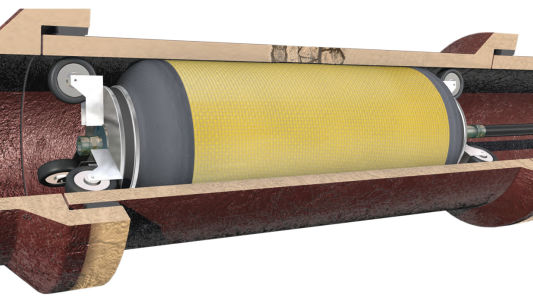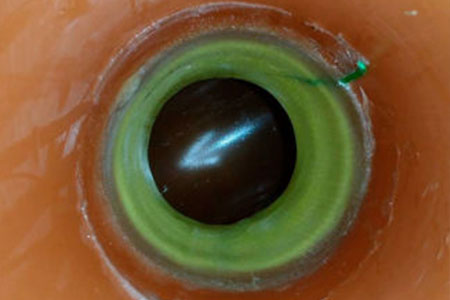Point repair
Point repair
A new generation balloon, wrapped in a fiberglass mat soaked in resin, is pushed with pneumatic means, or pulled with a rope up to the damaged point of the existing pipe whose coordinates have been previously produced with a television inspection.
Once the position is reached, the balloon is inflated with compressed air. In this way, the balloon expands up against the wall of the tube, crushing against it the resin-impregnated glass fibers.
The excess resin comes out and fills the damaged areas of the tube wall, where they remain permanently. The resin-impregnated glass fiber is then catalysed at room temperature, according to the instructions of the resin manufacturer. The polymerization times of the resin may vary depending on the conditions inside the tube.
Once the polymerization of the resin is complete, the balloon is deflated and removed from the conduit. At this point the fiberglass carpet covers the entire affected area without any hindrance to the flow. The rehabilitated pipe in this way is an integral structure that fully responds to the required hydraulic characteristics.
Side repair
For the side panels LCR balls are also used wrapped in resin and pushed by a series of pneumatic cylinders or on a trolley, or pulled by a rope up to the point to be repaired, the coordinates of which were previously produced with a television inspection. The peculiarity of these balloons is that they are equipped with a telescopic pole adjustable according to the angle of connection of the side channel and equipped with an inverted cap profile and impregnated with resin.
The rod, being telescopic, is located inside the balloon up to the point of the branch where it is extracted and inverted inside it by compressed air. Once the point to be repaired is reached, the compressed air is inflated inside the balloon. The rod that is inside is pushed out at the lateral branch of the tube and pushed against the edge of the connection point with a force that guarantees its seal.
The excess resin penetrates into the cavities of the damaged section forming a single body with the glass fibers of the cap and the walls of the existing tube. The profile of the hat is made specifically to guarantee the sealing of the space between the hat and the side, while the LCR balloon looks like a localized hose.
Both in the case of the flask and of the cap, the resin is polymerized at room temperature according to the instructions of its manufacturer. The polymerization times of the resin may vary depending on the conditions inside the tube. Once the resin is catalyzed, the balloon is deflated, the telescopic rod is withdrawn inside it and everything is removed from the pipe.
Pipe Bursting
It is a method that enables considerable savings compared to traditional methods with or without excavation.
____________________________________________________________________________________________
Pipe bursting is a well-known trenchless technology for the rehabilitation of deteriorated pipes and pipes. This is a method that allows significant savings compared to traditional methods with or without excavation.
The system foresees the use of a disruptive head that, advancing along the section of the pipeline to be replaced, produces, according to different modalities, the rupture simultaneously pushing the fragments into the surrounding soil. As the head moves forward and removes the old one, a new tube of equal or greater diameter is pulled into place.
The front part of the head is connected to a cable or to a battery of rods for towing, the rear part, instead, to the new pipe that can have a diameter equal to or greater than that of the existing pipe.
For the execution of this technology it is necessary to make two wells for accessing the pipeline or to use pre-existing manholes adapting them if necessary to the instrumentation to be inserted.
The head and the new pipe are inserted by one of the two wells (for insertion) and towed, by means of an external winch or a hydraulic rod puller, from the reception pit with a hydraulic expansion or pneumatic compression force according to the type of equipment used. The traction tension is transformed by the tip into the radial force necessary to break the old pipe, creating the space necessary for the insertion of the new one.
Pipe bursting is one of the most commonly used trenchless replacement technologies, its use is particularly suitable in the presence of a conduct of material having a fragile behavior. The tip of the head is usually smaller in diameter than the old tube so that it can always be kept well centered and therefore achieve a uniform break.
The base instead, having to cause the breaking of the old tube, is wider than the inner diameter of the latter and slightly wider also than the diameter of the new tube in order to reduce the friction on it and create sufficient space for the maneuvers.
The pipe bursting technology is obligatory in the event that it is necessary to rehabilitate pipes whose current capacity is no longer sufficient or affected by damage such as to render the other technologies without excavation ineffective. This is a definitely advantageous solution in terms of limiting damage to surface structures and traffic interruptions / deviations, as well as the environmental impact associated with this type of shipbuilding.
The main difference, as well as the advantage, of pipe bursting with respect to other trenchless technologies is represented by the possibility of replacing the existing pipeline with one of a larger diameter.
Although pipe-bursting methods are usually compared to other excavation-free technologies, it is important to stress that it is more a substitute rather than a rehabilitative system.


